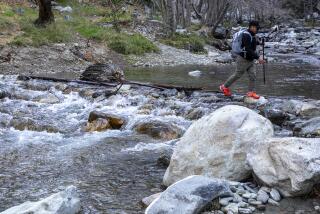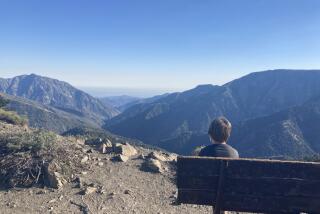Fire Season Begins at Los Padres Forest
- Share via
Recent dry weather has prompted rangers to impose fire restrictions at Los Padres National Forest about six weeks earlier than usual, spokesman Jim Youngson said.
The restrictions, which limit campfires and smoking throughout the forest, begin Friday. In addition, vehicle use at two local campgrounds is being restricted.
“We usually don’t have fire restrictions until late June or early July,” Youngson said. But “we have conditions out on the forest and in the back country that are much more like late August than late May, and that’s pretty scary.”
Los Padres National Forest, the most fire-prone in the nation, spends about half its annual budget fighting wildfires. An average of 20,000 acres burn each year on the almost 2-million acre forest.
The restrictions will remain in effect until fire season’s end, usually in late fall.
Specifically, open fires are banned outside designated campsites, even with a valid state campfire permit.
Lanterns and portable stoves are allowed with a valid permit, available at any Forest Service office. Forest visitors must clear all flammable material within five feet of their camp stove, have a shovel available and should not leave the stove unattended.
No smoking is permitted, except within an enclosed vehicle, building, designated campsite or while stopped in a barren area at least 3 feet in diameter.
In addition, driving has been banned until Oct. 1 into a dozen campsites at Lion Campground in the Rose Valley Recreation Area north of Ojai. Similar measures have been taken at Beaver Campground off California 33. The affected campsites remain accessible by foot.
The reason for the restrictions is that vehicles squash such sensitive species as the western pond turtle, the red-legged frog, the southwestern arroyo toad and the two-striped garter snake. The Forest Service has placed the restrictions on the campgrounds annually since 1994.
“Recreational use of breeding and rearing habitat has resulted in a reduction in the numbers of these animals,” said George Garcia, Ojai Ranger District biologist. “We are taking this action in an effort to allow greater reproductive success and help the recovery of the species.”
Moreover, sensitive habitat signs have been posted in both campgrounds and along nearby streams in an effort to prevent harm to the animals’ habitat.
More to Read
Sign up for Essential California
The most important California stories and recommendations in your inbox every morning.
You may occasionally receive promotional content from the Los Angeles Times.










